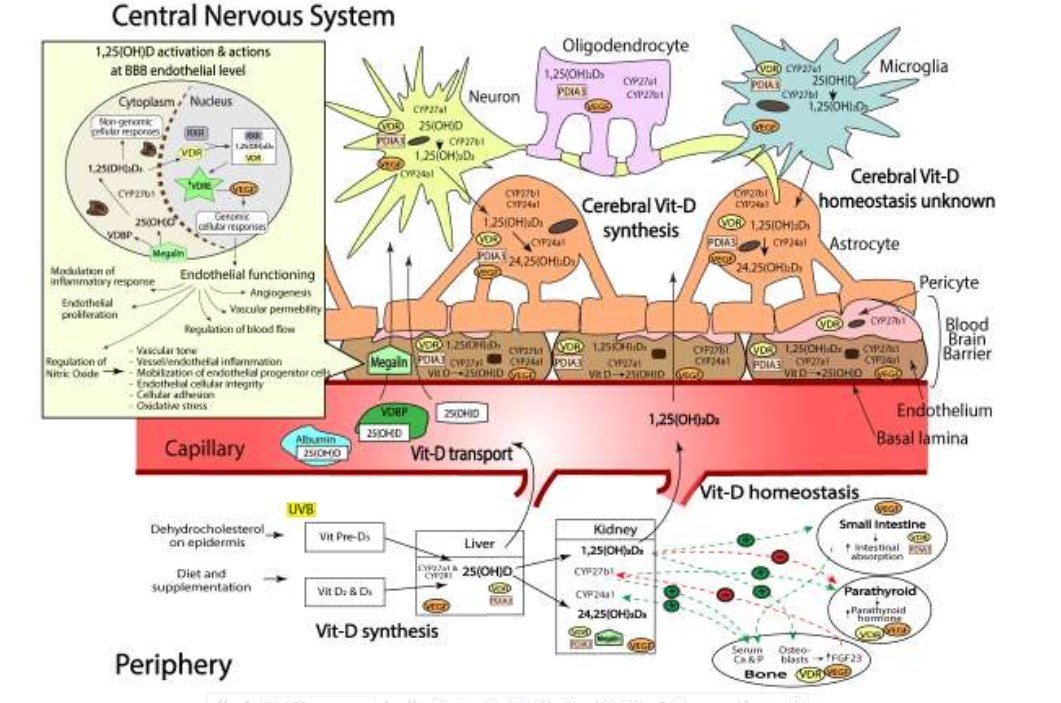Vitamin D in the Central Nervous System
Genetic, environmental and biomarker considerations delineating the regulatory effects of vitamin D on central nervous system function.
Br J Nutr. 2019 Oct 23:1-38. doi: 10.1017/S000711451900268X.

📄 Download the PDF from Sci-Hub via VitaminDWiki
Stephenson A1,2, Mamo JCL1,3, Takechi R1,3, Hackett MJ1,4, Lam V1,3.
1 Curtin Health Innovation Research Institute, Faculty of Health Sciences, Curtin University, Australia.
2 School of Pharmacy and Biomedical Sciences, Faculty of Health Sciences, Curtin University, Australia.
3 School of Public Health, Faculty of Health Sciences, Curtin University, Australia.
4 School of Molecular and Life Sciences, Faculty of Science and Engineering, Curtin University, Australia.
Studies show that vitamin D (vit-D) (25(OH)D); the bioactive metabolite (1,25(OH)2D3) and vit-D receptors (VDR: vit-D receptor; PDIA3: Protein-Disulphide-Isomerase, family A member 3) are expressed throughout the brain, particularly in regions pivotal to learning and memory. This has led to the paradigm that avoiding vit-D deficiency is important to preserve cognitive function. However, presently it is not clear if the common clinical measure of serum 25(OH)D serves as a robust surrogate marker for central nervous system (CNS) homeostasis or function. Indeed, recent studies report CNS-biosynthesis of endogenous 25(OH)D; the CNS expression of the CYP-group of enzymes which catalyse conversion to 1,25(OH)2D3 and thereafter, deactivation. Moreover, in the periphery, there is significant ethnic/genetic heterogeneity in vit-D conversion to 1,25(OH)2D3 and there is a paucity of studies which have actually investigated vit-D kinetics across the cerebrovasculature.
Compared to peripheral organs, the CNS also has differential expression of receptors that trigger cellular response to 1,25(OH)2D3 metabolites. To holistically consider the putative association of peripheral (blood) abundance of 25(OH)D on cognitive function, herein, we have reviewed population and genetic studies; pre-clinical and clinical intervention studies and moreover, have considered potential confounders of vit-D analysis.
Clipped from PDF
"Recently, another CNS-rich protein has been implicated in rapid intracellular signalling induced by 1,25(OH)2D3, namely Protein-Disulphide-Isomerase, family A member 3 ( PDIA3 ), a membranebound vit-D recepto r(70). Notably, the PDIA3 expression in brain is orders of magnitude greater than hepatic and renal PDIA3 expression, particularly in the cerebral cortex and hippocampus, regional areas critical to cognitive function (Fig. 1)"
"Consistent with the regional distribution of VDR, CYP27B1 was clearly indicated throughout the entirety of the CA1, CA2 and CA3- HPF regions, brain regions pivotal for spatial learning and memory formation and considered one of most vulnerable regions in Alzheimer’s disease pathology
"In Alzheimer’s disease, hypovitaminosis-D is associated with a 2.4 fold increased risk for cognitive impairment(14)"
